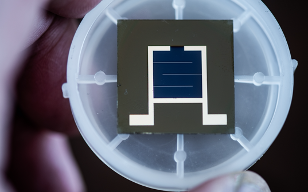 Maths, Physics & Chemistry
Maths, Physics & Chemistry
A match made in heaven: Stacking two solar cells boosts their efficiency
Metal halide perovskites improve the efficiency of silicon solar cells by 30%.

The development and realization of clean, renewable energy is one of the significant problems of our time. Over 850 million people do not have access to electricity. We must find a way to deliver it while maintaining a sustainable climate and air pollution standards. Solar energy is poised to meet the need: the sun imparts more solar energy to the earth in 2 hours than we need to power the entire planet for a year. However, for widespread adoption, photovoltaics need to deliver electricity that costs less than that from other sources such as coal and natural gas. For solar cells, in particular, this cost is unique. The upfront price of a solar panel is returned over a long time (typically more than 20 years), in which the solar panel continues to produce electricity as the sun shines. The more efficient a solar cell is, the more sunlight it will convert to electricity over its lifetime. The more stable a solar cell is, the less efficiency it will lose over time, allowing it to operate at full capacity for longer. Therefore, the three determinants in solar electricity cost are the initial price, efficiency, and lifetime of an installed solar module.
The current market-dominant solar technology is silicon, primarily due to massive increases in manufacturing capacity in China and technological advances in efficiency that have decreased the cost of silicon solar electricity over the last ten years. However, further decreases in the price of silicon solar cells are starting to level off as the cost of a silicon solar module is mainly composed of external costs to the solar cell itself, such as the mounting, wiring, and installation costs. Besides, further increases in efficiency are limited as silicon solar cells come closer to their theoretical maximum efficiency. One way to overcome this theoretical maximum is to stack two solar cells on top of each other with different electrical band gaps to absorb different colors of light or different portions of the solar spectrum. So-called multijunction or tandem solar cells have existed for decades, but with the drawback that they have been extremely expensive to manufacture.
About ten years ago, a new material called metal-halide perovskites was found to make efficient solar cells using inexpensive materials and processing techniques. In addition, these perovskite materials could be tuned to absorb different portions of the solar spectrum, making them a perfect candidate for tandem solar cells at a fraction of the cost of previous tandems. Since then, many academic and industrial teams have focused on placing perovskite solar cells on top of silicon solar cells to boost their efficiency, creating perovskite/silicon tandem cells. However, early perovskite solar cells had poor stability. The compositions that absorbed the correct portions of the solar spectrum for tandems typically exhibited lower efficiencies than other compositions that are not "ideally matched" for perovskite/silicon tandems.
In our work, we investigated a new metal halide perovskite alloy by combining three different halogen elements (iodine, bromine, and chlorine) to achieve both high efficiencies with an "ideally matched" band gap and high stabilities. The best previous perovskite tandem solar cells only used iodine and bromine. We found that the addition of chlorine helped improve both the efficiency and stability of the perovskite material. Our prototype perovskite/silicon tandem took a typical 21% silicon solar cell, a product responsible for a $30 billion a year industry. It improved its efficiency by 30% to 27%. In addition, the devices held that initial efficiency over 1000 hours (about 42 days) of intensive light and heat testing, a promising result for this new material class that could equate to about a year of "real-life" stability in the field.
This result has immediate implications for the industry. Many startups such as Oxford PV and established silicon solar cell manufacturers look to manufacture and market perovskite/silicon tandems as the "next-gen" solar technology. The next step for both academia and industry is to identify accelerated aging conditions to evaluate whether the improved perovskite cells can withstand 20+ years in the field. While we performed our study on a lab-scale 1 cm2 device, Oxford PV has demonstrated full-sized perovskite/silicon modules and plans to release modules commercially within the next few years. Perovskite/silicon tandems could soon be on your rooftop!
Original Article:
Xu J, Boyd C, Yu Z et al. Triple-halide wide–band gap perovskites with suppressed phase segregation for efficient tandems. Science (1979). 2020;367(6482):1097-1104.
Next read: The Lingering Shadow of Redlining: Fossil Fuel Power Plants and Air Pollution by Lara Cushing , Shiwen Li
Edited by:
Massimo Caine , Founder and Director
We thought you might like
More from Maths, Physics & Chemistry
Testing gravity through the distortion of time
Sep 20, 2024 in Maths, Physics & Chemistry | 3 min read by Sveva CastelloStacking molecular chips in multiple dimensions
Aug 30, 2024 in Maths, Physics & Chemistry | 3 min read by Lucía Gallego , Romain Jamagne , Michel RickhausReversible Anticoagulants: Inspired by Nature, Designed for Safety
Jun 12, 2024 in Maths, Physics & Chemistry | 4 min read by Millicent Dockerill , Nicolas WinssingerDistance-preserving moves always keep a point fixed
May 18, 2024 in Maths, Physics & Chemistry | 4 min read by Shaula FiorelliA resonance triggers chemical reactions between the coldest molecules
Apr 5, 2024 in Maths, Physics & Chemistry | 3 min read by Juliana Park , Wonyl ChoiEditor's picks
Trending now
Popular topics


